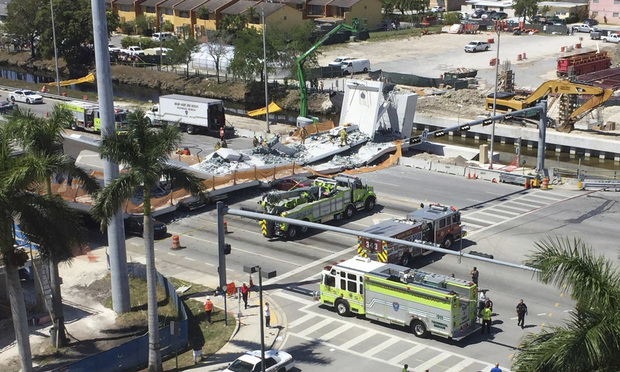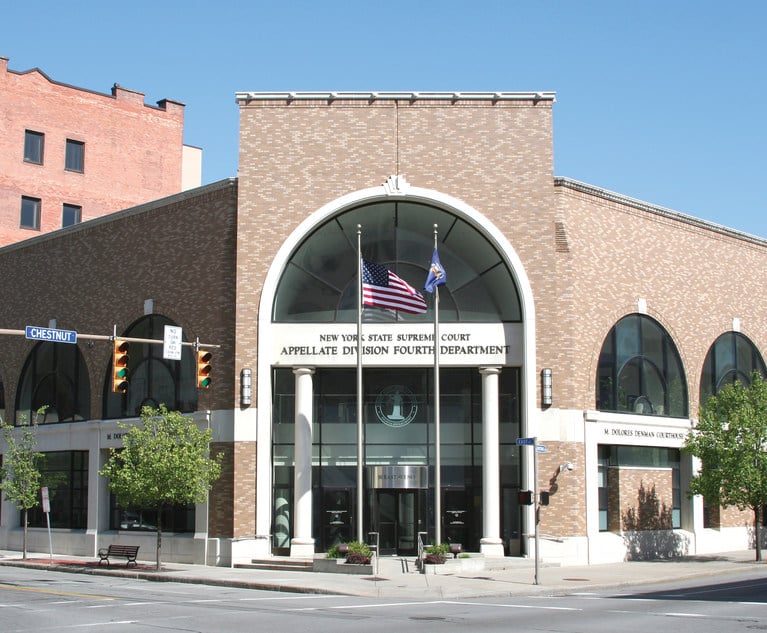'They've All Got to Be Sweating Tacks': Attorneys Discuss Liability Over FIU Bridge Collapse
Expect a lot of finger-pointing in what attorneys say will likely be multimillion-dollar litigation arising from Thursday's bridge collapse at Florida…
March 16, 2018 at 03:49 PM
5 minute read

Expect a lot of finger-pointing in what attorneys say will likely be multimillion-dollar litigation arising from Thursday's bridge collapse at Florida International University.
The 174-foot bridge weighing 950 tons collapsed onto a state road, Southwest Eighth Street, near FIU's campus in Sweetwater. It crushed several lanes of traffic below, killing at least six people, according to death toll reports released as crews continued rescue and recovery efforts Friday.
Now, it will be up to courts and investigators to figure out what went wrong and who's to blame, as the university, state Department of Transportation, engineers, contractors, designers and others involved in the project go on the offensive.

“They've all got to be sweating tacks. They'll be very very nervous about their liability,” said James R. Schwebel, a Minneapolis personal injury attorney who helped win $52.4 million for plaintiffs after a Minnesota bridge collapse in 2007. “They'll have insurance coverage, but will they have enough? When the dust settles, the scene will be swarming with all sorts of engineering firms hired by the parties involved, starting with the state of Florida. …Typically they're all going to be pointing the finger at each other.”
South Florida personal injury attorneys say the most likely first step is a root-cause analysis to determine the specific failure that brought down the bridge. That evaluation will consider design, structural integrity and construction, as well as pinpointing which company made specific decisions about the project.
“I would look directly at the contractor and bridge engineer, and I would look most closely at the construction firm,” said Stuart N. Ratzan, the Ratzan Law Group Miami shareholder who in 2017 won a $45 million verdict against a construction company over a crash on Interstate 75. “But I would also say for any root cause analysis, you go into it with an open mind and you get to the bottom of it.”
The $14.3 million structure was meant to be a walkway that allowed pedestrians to avoid navigating the busy street below. It was pre-fabricated using new construction and design technology, and transported to the construction site for installation. The idea was to safeguard the FIU community, and complete the project with minimal disruption to traffic.
But Thursday's tragedy showed the opposite happened.
“I believe the focus needs to be right now on the victims of this terrible tragedy and their families,” said David Haber, a Miami attorney whose recent victories include a $22.5 million settlement in a Palm Beach County construction defect case. “It is unfortunate and sadly ironic that this alleged 'safer' technique of building bridges, which was intended to save lives during construction, turns out to be a death trap.”
Going forward, prospective plaintiff lawyers will likely build their case around individualized losses, attempting to assign blame while demonstrating the extent of the victims' or survivors' suffering.

“I can tell you … that there is absolute liability. It's 100 percent carelessness,” said personal injury lawyer Scott Schlesinger. “The damages are substantial, unfortunately. … It' so individualized, it's better to just gather up the evidence and be ready to provide the meaning of the lost lives to the jury. The whole idea of what we do is that we humanize it.”
By Friday morning, some of the groups involved had started to speak out. The Florida Department of Transportation, for instance, noted the bridge was a local agency project, not an FDOT venture. The designer, contractor and construction engineering, and inspection functions were all under contract with FIU, it noted.
In a statement Thursday night, FDOT said it played a limited role. It issued a permit for traffic control during installation of the bridge last Saturday, acted as a pass-through for federal funding, and provided $57,000 in state funding; and conducted a routine preliminary review. It also authorized the university to use the aerial space above the state road to build a structure—a structure it said “FIU and its contractors are solely responsible to inspect and maintain at the university's sole expense.”
Florida law limits the liability of government agencies to $200,000, or up to $300,000 if the case involves multiple agencies.
But attorneys say all the public agencies involved in the project will likely end up as defendants alongside the private companies in civil law suits stemming from the bridge's collapse.
“Whoever brings a lawsuit on behalf of the victims and their families is going to bring everybody in,” said Miami commercial and corporate litigator Jason Kellogg, partner at Levine Kellogg Lehman Schneider + Grossman. “It seems like there will be a high likelihood of finger-pointing because of the novelty of this bridge design.”
Meanwhile, Bolton Perez & Associates, the project's construction engineering and inspection firm, issued a statement Friday expressing “deep sadness.”
“Our hearts and prayers go out to the victims and their families, including those members of our own Bolton Perez & Associates family who were injured yesterday,” it said. “We intend to cooperate in every way we can to assist local, state and National Transportation Safety Board investigators in determining the cause of this terrible incident and to help prevent any future tragedies of this kind.”
MCM, the company that built the bridge offsite and transported it to FIU, said it's cooperating with federal investigators.
“Our thoughts are with the families and victims,” it said in a statement. “We have been in business for more than 35 years, and safety has always been our number one priority. We are just heartbroken.”
Project designer Tallahassee-based FIGG Engineering Group did not respond to requests for comment by press time.
This content has been archived. It is available through our partners, LexisNexis® and Bloomberg Law.
To view this content, please continue to their sites.
Not a Lexis Subscriber?
Subscribe Now
Not a Bloomberg Law Subscriber?
Subscribe Now
NOT FOR REPRINT
© 2025 ALM Global, LLC, All Rights Reserved. Request academic re-use from www.copyright.com. All other uses, submit a request to [email protected]. For more information visit Asset & Logo Licensing.
You Might Like
View All
Trump Media Accuses Purchaser Rep of Extortion, Harassment After Merger
4 minute read
Who Got the Work: Array of National Lawyers Appearing in Appeal Over Social Media Role in Buffalo Massacre

Tax Company Exactera Sues Ex-CEO, Alleging Harassing Litigation

New Precedent: Lawyers Took Too Long, So Litigants Struck a Doomed Deal
Trending Stories
- 1Silk Road Founder Ross Ulbricht Has New York Sentence Commuted by Trump
- 2Settlement Allows Spouses of U.S. Citizens to Reopen Removal Proceedings
- 3CFPB Resolves Flurry of Enforcement Actions in Biden's Final Week
- 4Judge Orders SoCal Edison to Preserve Evidence Relating to Los Angeles Wildfires
- 5Legal Community Luminaries Honored at New York State Bar Association’s Annual Meeting
Who Got The Work
J. Brugh Lower of Gibbons has entered an appearance for industrial equipment supplier Devco Corporation in a pending trademark infringement lawsuit. The suit, accusing the defendant of selling knock-off Graco products, was filed Dec. 18 in New Jersey District Court by Rivkin Radler on behalf of Graco Inc. and Graco Minnesota. The case, assigned to U.S. District Judge Zahid N. Quraishi, is 3:24-cv-11294, Graco Inc. et al v. Devco Corporation.
Who Got The Work
Rebecca Maller-Stein and Kent A. Yalowitz of Arnold & Porter Kaye Scholer have entered their appearances for Hanaco Venture Capital and its executives, Lior Prosor and David Frankel, in a pending securities lawsuit. The action, filed on Dec. 24 in New York Southern District Court by Zell, Aron & Co. on behalf of Goldeneye Advisors, accuses the defendants of negligently and fraudulently managing the plaintiff's $1 million investment. The case, assigned to U.S. District Judge Vernon S. Broderick, is 1:24-cv-09918, Goldeneye Advisors, LLC v. Hanaco Venture Capital, Ltd. et al.
Who Got The Work
Attorneys from A&O Shearman has stepped in as defense counsel for Toronto-Dominion Bank and other defendants in a pending securities class action. The suit, filed Dec. 11 in New York Southern District Court by Bleichmar Fonti & Auld, accuses the defendants of concealing the bank's 'pervasive' deficiencies in regards to its compliance with the Bank Secrecy Act and the quality of its anti-money laundering controls. The case, assigned to U.S. District Judge Arun Subramanian, is 1:24-cv-09445, Gonzalez v. The Toronto-Dominion Bank et al.
Who Got The Work
Crown Castle International, a Pennsylvania company providing shared communications infrastructure, has turned to Luke D. Wolf of Gordon Rees Scully Mansukhani to fend off a pending breach-of-contract lawsuit. The court action, filed Nov. 25 in Michigan Eastern District Court by Hooper Hathaway PC on behalf of The Town Residences LLC, accuses Crown Castle of failing to transfer approximately $30,000 in utility payments from T-Mobile in breach of a roof-top lease and assignment agreement. The case, assigned to U.S. District Judge Susan K. Declercq, is 2:24-cv-13131, The Town Residences LLC v. T-Mobile US, Inc. et al.
Who Got The Work
Wilfred P. Coronato and Daniel M. Schwartz of McCarter & English have stepped in as defense counsel to Electrolux Home Products Inc. in a pending product liability lawsuit. The court action, filed Nov. 26 in New York Eastern District Court by Poulos Lopiccolo PC and Nagel Rice LLP on behalf of David Stern, alleges that the defendant's refrigerators’ drawers and shelving repeatedly break and fall apart within months after purchase. The case, assigned to U.S. District Judge Joan M. Azrack, is 2:24-cv-08204, Stern v. Electrolux Home Products, Inc.
Featured Firms
Law Offices of Gary Martin Hays & Associates, P.C.
(470) 294-1674
Law Offices of Mark E. Salomone
(857) 444-6468
Smith & Hassler
(713) 739-1250






